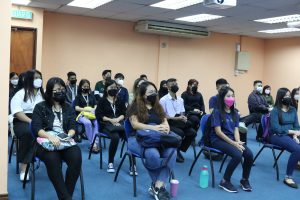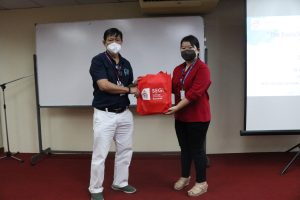By Ms Candy Chong, Programme Leader, Faculty of Allied Health Sciences
SEGi College Sarawak’s Faculty of Allied Health had the pleasure to have Mr Kho, the Laboratory Manager of Borneo Medical Centre Kuching, at our Branch Campus for a talk entitled “The Evolution of Medical Laboratory Technologies” on 5th April 2022. A group of thirty students from our Diploma in Medical Laboratory Technology and Diploma in Healthcare took part in the session. The purpose of this talk was to inform the students of the current needs of the laboratory industry and the criteria to be employed as medical laboratory technologists in both the private and government sectors.
Mr Kho is a certified medical laboratory technologist with more than forty years of working experience in this industry. He spoke passionately about the evolution of the laboratory in terms of improved in both technology equipment and techniques, and explained that there are seven areas in a medical laboratory, namely the blood bank, cytology, histopathology, clinical biochemistry, medical parasitology, medical microbiology, and haematology. He added that all laboratories have been applying manual diagnostic methods in the past decades, and that a laboratory needs about forty staff members to carry out all the tests with different parameters.
In this digital age though, the majority of these manual tests have been replaced by automated tests to fulfil the needs of the patients and to minimise the time taken to get results. This evolution has had a huge impact on the medical laboratory field, where the number of people required for each laboratory has been tremendously decreased. The previous workload that required forty staff members can now be handled easily by only ten people. Mr Kho added confidently that although this might seem to pose a cause of concern about job opportunities for graduates of medical-laboratory technology, the outlook is actually very positive because of technology has created additional areas in the field.
Mr Kho also spoke about the diagnostic methods and equipment used in the medical laboratory. The majority of the sections in the laboratory have had both semi- and fully automated equipment installed to avoid misdiagnoses due to human error and to ensure the accuracy of all test results. However, all medical laboratory students should know the manual method for each test to ensure that the diagnoses can still carry on if the equipment ever breaks down.
A few students raised questions about their career pathways after the diploma, all of which Mr Kho answered. At the end of the session, the programme leader presented Mr Kho with a souvenir as a token of appreciation from the college. Mr. Kho gave some encouraging words to the students and wished them all the best.




